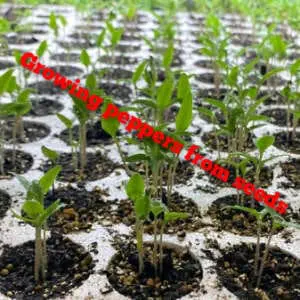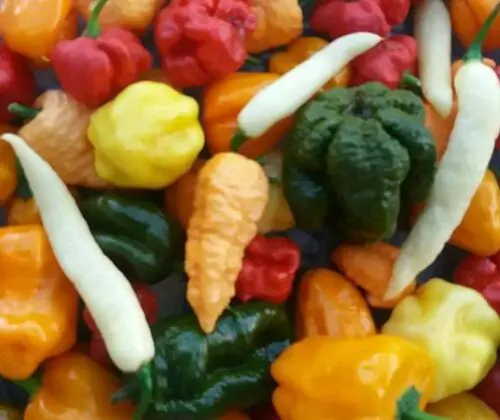Growing chili peppers from seeds in one’s garden is something all spice lovers would absolutely love to do. You would not even have to go out to buy them, or eat a spice-less dinner once they are finished; in fact, all you will need to do is to go out in your garden and pick some off. Each plant has its own requirements to grow properly and stay healthy during the process of growing and even after that.
The amount of fertilizers, good soil, sunlight, water, temperature, location, and space, the distance between the plants for planting is essential to consider while growing the chilipeppers plant. Chili pepper plants have their own specifications, which you should keep in mind while planting them. This guide will provide you with the most basic and necessary details before you start planting up your garden.
follow our advice on how growing peppers:
Things to Remember
Peppers take their time while growing, so before transferring them outside, you should plant them indoors and keep them inside for some weeks (approximately 4-8 weeks) before taking them outside. Make sure that the soil is moist most of the time and not dry, but do not over-water the plants. 80-85 degrees Fahrenheit is the ideal temperature to keep them indoor. You will need to make sure that the room they are in has a proper amount of sunlight.
After 4-8 weeks, transfer them out in the soil; keep in mind that they will grow more where there is a lot of sunlight. Add some manure or compost to keep the soil moist and fertilized, or you can also use a mixture of seaweed and fish emulsion.
Spacing and Watering
Many new gardeners don’t pay heed to spacing while planting, which usually results in disappointment. Adequate spaces are necessary to help ensure that the plant has enough room to grow, spread, and to have ample amount of air circulating in between and around the plants. This makes spotting pests a hassle-free job. Chilies need to be planted with a distance of 2-3 feet between them, and need to be around 18-36” apart. This will help the chilies grow up to 3 ft. tall.
The soil should be watered often, but not to the point where it turns the soil soggy. Water the peppers every other day or third day, so that they won’t be inundated or be at the risk of rotting. Also, keep adding good plant food to keep them growing healthily.
Weeds
They are one of the most common problems that stunt the growing process of plants. To avoid that, keep a look out for weeds, and get rid of them before they ruin your peppers and hard work.
There are numerous ways of harvesting chili peppers; here is a list of some methods you can use to grow them and see which one suits you the best regarding your convenience.
• Growing peppers from Seeds
Growing chili peppers from seeds is not a laborious task, although it does require patience. Plant 2 to 3 seeds in a seed tray or small plastic cup and add a small amount of potting soil or compost. Moisten the soil until the seeds sprout, I recommend burying the seeds to a depth of 0.20 inches
Seed trays are best for this method, as the tray lid retains moisture and frequent watering would not be required. Before the sprouts come out, keep the seeds in a dark area where they are exposed to a small amount of filtered light. After the sprouts have appeared, remove the lid and place the tray on a windowsill that has plenty of sunlight. Watering every three days is vital now.
• Growing peppers in the Ground
When the last frost has melted, wait a few weeks before planting the seeds. The temperature of the soil should be a minimum of 60 ° F. Choose a place that is exposed to sunlight for 6 hours straight, as the sun is the favorite food of the chili plants. Make sure the hole is dug twice the width of the pot and that the soil level reaches the leaves.
When the plants reach a height of about 3 feet tall, use props, as they would begin to lean out with the weight of the peppers. Make sure the soil is well fertilized, watered, and pests are properly kept under control. If the peppers are small, use a good fertilizer; it will not need to be used in open ground if previously fertilized, unless they are growing in pots, but it is essential for small chillies.
• Indoor Planting
The first thing to keep in check is the temperature. Mostly peppers love the warm temperature, but a lot of them prefer a cooler temperature in the evenings , for example the Rocoto and the variety of Capsicum annuum. Many of them grow well in moderate humidity and sunlight, but some of them grow best in moderate temperatures and high humidity. Keep the plants in a proper sunlit room, and keep the soil moist, not wet.
Fertilize the plants once every two weeks to ensure proper growth. Also, keep in check that the air quality isn’t polluted with harmful irritants that will kill the chili plants.
Now that you have found out some methods of growing chilies, it is time to find out how to harvest them.
Harvesting Peppers
To prevent the plant from being damaged, use a knife or garden clippers while removing the chili peppers. Wear gloves when picking the hot ones, as the oils can cause irritation to your skin. wash your hands after picking them to avoid burning your eyes and face, in case you touch them. Make sure that the plants are dry during harvesting period to prevent any disease, even if it is not visible.
When the peppers have grown, they will come off the plant effortlessly. if you have to pull them a bit, they are still growing and not ready to be picked off. Sometimes, small brown colored lines form on the peppers; these lines indicate that the pepper is ripe and ready to pull off, regardless of its size.
If the pepper is not ripe, place it on a windowsill that faces the sun.
we are at the end of our guide now you know how growing peppers from seeds
have a good fun



